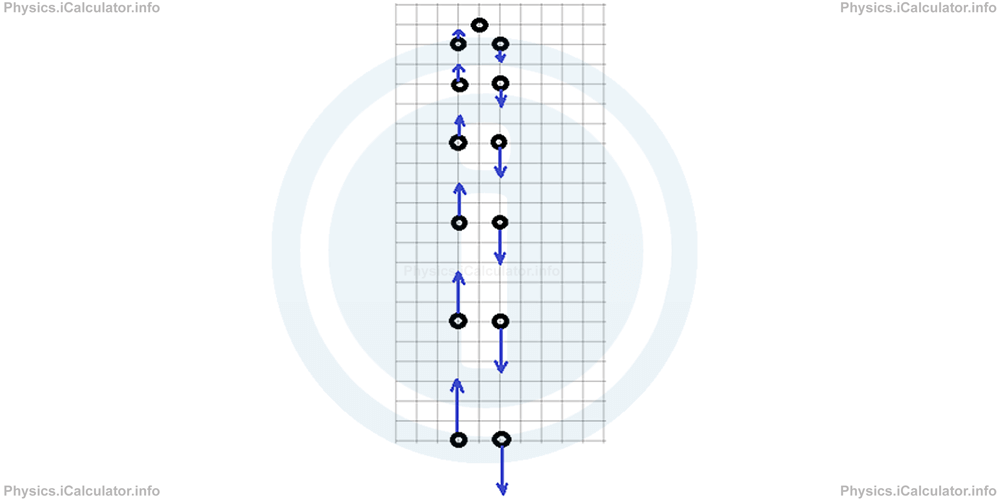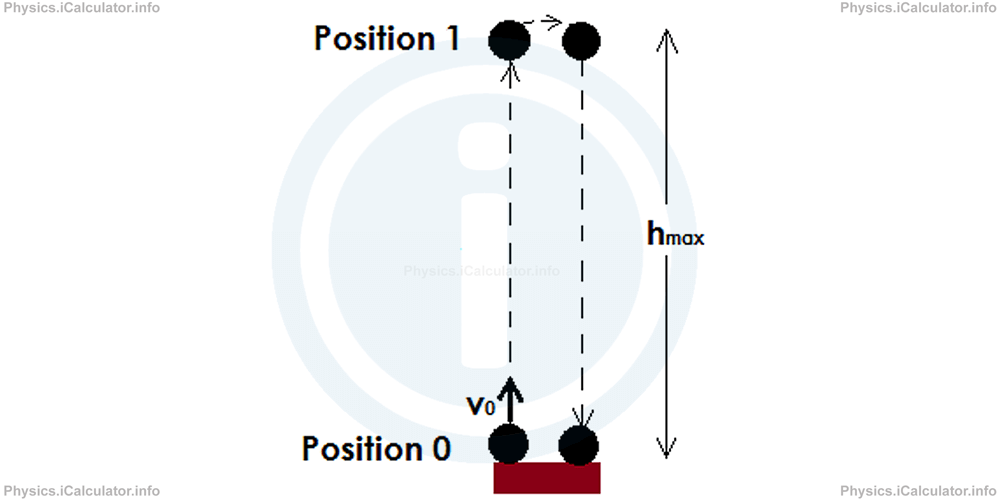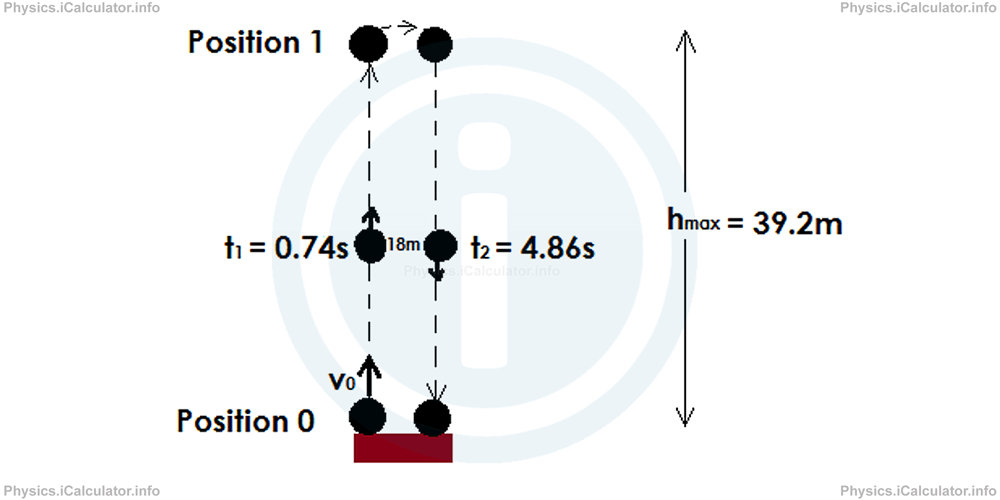Menu
Physics Lesson 3.8.3 - Vertical Motion. Free Fall as a Special Case of Vertical Motion
Please provide a rating, it takes seconds and helps us to keep this resource free for all to use
Welcome to our Physics lesson on Vertical Motion. Free Fall as a Special Case of Vertical Motion, this is the third lesson of our suite of physics lessons covering the topic of Equations of Motion, you can find links to the other lessons within this tutorial and access additional physics learning resources below this lesson.
Vertical Motion. Free Fall as a Special Case of Vertical Motion
As discussed in the previous tutorial "The Meaning of Acceleration. Constant and Non-Constant Acceleration. Gravitational Acceleration", when objects are at a certain height from the ground, they fall down as the Earth attracts them due to its gravity. We stated that this kind of motion is uniformly accelerated motion when falling down and uniformly decelerated motion when going up. The motion map below helps making this idea clearer.

The interpretation of the motion map is as follows:
"The object is thrown vertically upwards from the ground. It decelerates as the gravity acts against motion. This deceleration occurs until the object reaches its maximum height. Then it stops for a very short instant and afterwards it changes the direction of motion, i.e. it starts falling down. During this process, the object accelerates as the gravity now act in the direction of motion. Therefore, the object reaches the ground moving at a final velocity that is numerically equal to the initial velocity but in the opposite direction."
The gravitational acceleration (denoted by g⃗ instead of a⃗ to make it distinct from the horizontal acceleration), has two fixed values near the Earth surface (as explained in the previous tutorial). They are +9.81 m/s2 when moving up and -9.81 m/s2 when falling down. Therefore, if writing the symbol of the height h⃗ instead of displacement ∆x⃗, the four equations of the motion with constant acceleration discussed in the previous paragraph, become:
Equation i
v⃗ = v⃗0 + g⃗ × ∆tEquation ii
h⃗ = v⃗ + v⃗0/2 × ∆tEquation iii
v⃗2 - v⃗20 = 2 × g⃗ × h⃗Equation iv
h⃗ = v⃗0 × ∆t + g⃗ × ∆t2/2Example 2
An object is thrown upwards from the ground at 28 m/s. Calculate
- The maximum height the object can reach
- The instant (s) when the object will be 18 m above the ground.
Solution 2
The situation is visually described in the figure below

The maximum height h⃗max is reached when the object after starting moving upwards from the ground (position 0) goes at the highest position (position 1), where it stops for an instant and prepares for turning back at the ground (position 0). Therefore, the velocity in that position is v⃗1 = 0.
Using the equation (III)
we obtain for the maximum height h⃗ after the substitutions (for convenience, let's take the magnitude of gravitational acceleration as 10 m/s2 instead of 9.81 m/s2)
-784 = -20 × h⃗max
h⃗max = -784/-20
= 39.2 m
(The gravitational acceleration is taken as negative as the object is slowing down when moving upwards).
The object will be twice at 18 m above the ground: one when moving up and the other when falling down. Therefore, since we have to obtain two different results for the time t (or Δt, it is the same thing), we must consider the equation (iv) as it is the only one in which the time t is at power 2 (i.e. is quadratic). Now, the height h⃗ is known; it is h⃗ = 18m. Thus, we have:
18 = 28 × t + (-10) × t2/2
18 = 28 × t - 5 × t2
5 × t2 - 28t + 18 = 0
As stated before, this is a quadratic equation, i.e. an equation of the form
where A, B and C are constants and x is the variable. In our example, we have A = 5, B = -28, C = 18 and x = t. Therefore, since the discriminant
= 282 - 4 × 5 × 18
= 784 - 360
= 424
is positive, we have two different roots for this equation which represent the required times. Hence,
= -(-28) - √424/2 × 5
= 28 - 20.6/10
= 7.4/10
= 0.74 s
and
= -(-28) + √424/2 × 5
= 28 + 20.6/10
= 48.6/10
= 4.86 s
It is obvious the first solution (t1 = 0.74 s) represents the time in which the object is 18 m above the ground when rising up, while the second solution represents the time in which the object is again at 18 m above the ground but this time when it ia falling down. The figure below clarifies this point.

You have reach the end of Physics lesson 3.8.3 Vertical Motion. Free Fall as a Special Case of Vertical Motion. There are 4 lessons in this physics tutorial covering Equations of Motion, you can access all the lessons from this tutorial below.
More Equations of Motion Lessons and Learning Resources
Whats next?
Enjoy the "Vertical Motion. Free Fall as a Special Case of Vertical Motion" physics lesson? People who liked the "Equations of Motion lesson found the following resources useful:
- Vertical Feedback. Helps other - Leave a rating for this vertical (see below)
- Kinematics Physics tutorial: Equations of Motion. Read the Equations of Motion physics tutorial and build your physics knowledge of Kinematics
- Kinematics Revision Notes: Equations of Motion. Print the notes so you can revise the key points covered in the physics tutorial for Equations of Motion
- Kinematics Practice Questions: Equations of Motion. Test and improve your knowledge of Equations of Motion with example questins and answers
- Check your calculations for Kinematics questions with our excellent Kinematics calculators which contain full equations and calculations clearly displayed line by line. See the Kinematics Calculators by iCalculator™ below.
- Continuing learning kinematics - read our next physics tutorial: Position v's Time and Distance v's Time Graph
Help others Learning Physics just like you
Please provide a rating, it takes seconds and helps us to keep this resource free for all to use
We hope you found this Physics lesson "Equations of Motion" useful. If you did it would be great if you could spare the time to rate this physics lesson (simply click on the number of stars that match your assessment of this physics learning aide) and/or share on social media, this helps us identify popular tutorials and calculators and expand our free learning resources to support our users around the world have free access to expand their knowledge of physics and other disciplines.